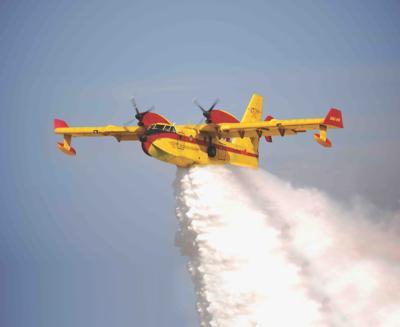Mon, Sep 12, 2022
RescEU Fleet May Grow Sooner Than Expected After Blazing Summer Stretches EU Firefighting Capacity
The EU might be on track to establish its own dedicated firefighting fleet after a rough summer put fire readiness into harsh focus.

European Union member states agreed to the plan after a series of wildfires exceeded their overall firefighting ability and quickly led to thousands of evacuations and billions in damage. Southern Euro countries are an expected hotspot, but 2022 saw the addition of uncontrollable blazes much further North, with Germany and the Czech Republic suffering under high temperatures and quickly advancing fire lines. The European Commission and EU ministers agreed to explore advanced purchase of firefighting equipped helicopters.
The plan doesn't come out of left field, but advances the timeline on an extant plan to procure a fleet of crisis-ready aircraft beyond the current rescEU fleet. Traditionally, the Union coordinates with member states to place aircraft into a pool of firefighting assets. Under the current scheme, member countries are responsible for fire response, with EU assistance available should their capacity to fight the blaze be insufficient. So far this year, such requests have been made 11 times, up from 9 in 2021. While a modest increase, that number may actually be lower than it should be since member states abstained from sending a call they believed would not be answered.
Head of crisis management, Janez Lenarcic, gave an honest assessment of the EU's firefighting capability when he said that things were not where they needed to be should worsening wildfire activity continue. "At the European level, we have reached our capacity limit. Some overwhelming fires in some member states did in fact not lead to a request for assistance because the countries concerned knew that no capacities would have been available.
The purchase of the aircraft will be contingent upon additional EU funds being apportioned from the 2023 budget, making the buy somewhat iffy overall. Buying the aircraft might not seem as vital a purchase when inflation and energy infrastructure are making headlines, especially when the Union is able to pool resources from all across the EU for use where needed. If funded, the production slots may already be assigned to other buyers, since the original plan had the firefighting fleet being produced in the later part of this decade.
More News
Aero Linx: Transport Canada We are a federal institution, leading the Transport Canada portfolio and working with our partners. Transport Canada is responsible for transportation p>[...]
Gross Navigation Error (GNE) A lateral deviation from a cleared track, normally in excess of 25 Nautical Miles (NM). More stringent standards (for example, 10NM in some parts of th>[...]
From AirVenture 2017 (YouTube Edition): Flight-Proven Booster On Display At AirVenture… EAA AirVenture Oshkosh is known primarily as a celebration of experimental and amateu>[...]
Aircraft Parachute System (CAPS) Was Deployed About 293 Ft Above Ground Level, Which Was Too Low To Allow For Full Deployment Of The Parachute System Analysis: The day before the a>[...]
Also: 48th Annual Air Race Classic, Hot Air Balloon Fire, FAA v Banning 100LL, Complete Remote Pilot The news Piper PA-18 Super Cub owners have been waiting for has finally arrived>[...]
 ANN's Daily Aero-Linx (06.29.25)
ANN's Daily Aero-Linx (06.29.25) ANN's Daily Aero-Term (06.29.25): Gross Navigation Error (GNE)
ANN's Daily Aero-Term (06.29.25): Gross Navigation Error (GNE) Classic Aero-TV: Anticipating Futurespace - Blue Origin Visits Airventure 2017
Classic Aero-TV: Anticipating Futurespace - Blue Origin Visits Airventure 2017 NTSB Final Report: Cirrus SR22
NTSB Final Report: Cirrus SR22 Airborne Affordable Flyers 06.26.25: PA18 Upgrades, Delta Force, Rhinebeck
Airborne Affordable Flyers 06.26.25: PA18 Upgrades, Delta Force, Rhinebeck



